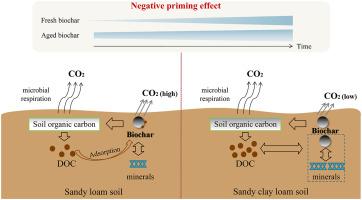Soil Biology and Biochemistry ( IF 9.8 ) Pub Date : 2022-04-06 , DOI: 10.1016/j.soilbio.2022.108657 Yan Yang 1 , Ke Sun 1 , Lanfang Han 2 , Yalan Chen 1 , Jie Liu 1 , Baoshan Xing 3

|
The carbon sequestration potential of biochar depends on its stability in the soil and its priming effect on native soil organic carbon mineralization, which could be expected to be in turn affected by biochar processing, aging and soil clay content. This study applied stable carbon isotopes (δ13C) to quantify the mineralization of fresh and aged biochar pyrolyzed at 300, 450, and 600 °C and their priming effects on native soil organic carbon in two types of soils with different clay contents. At the end of the incubation, the total carbon loss of biochar-amended soil was 16–53% lower than that of unamended soil and the lowest carbon loss was found in soils amended with 600 °C biochar. Regardless of soil type, the proportion of biochar-carbon (carbon in the biochar) mineralized decreased with increasing pyrolysis temperature. For fresh biochar, the proportion of carbon mineralized was 13–47% higher in the sandy loam soil than in the sandy clay loam soil at the end of the incubation. However, soil type had a minimal effect on the mineralization proportion of aged biochar-carbon. The dissolved organic carbon increased after fresh and aged biochar was added to the sandy clay loam, but not the sandy loam, suggesting less carbon hydrolysis and solubilization from native soil organic carbon and biochar in the sandy loam soil. Moreover, biochar amendment increased the enzyme activities in sandy clay loam soil and either increased or had no effect on those in sandy loam soil. Fresh biochar had no effect on native soil organic carbon mineralization after it was applied, although a negative priming effect was observed after two−7 wk. For aged biochar, a negative priming effect was found for both soils. These findings demonstrated that biochar was more stable in clayey soils, and biochar produced at higher temperature indeed showed high soil carbon sequestration potential.
中文翻译:

生物炭稳定性和对土壤有机碳矿化的影响取决于生物炭加工、老化和土壤粘土含量
生物炭的固碳潜力取决于其在土壤中的稳定性及其对原生土壤有机碳矿化的启动作用,预计这反过来又会受到生物炭加工、老化和土壤粘土含量的影响。本研究应用了稳定的碳同位素 (δ 13C) 量化在 300、450 和 600 °C 下热解的新鲜和陈年生物炭的矿化作用及其对两种不同粘土含量土壤中原生土壤有机碳的引发效应。在孵化结束时,生物炭改良土壤的总碳损失比未改良土壤低 16-53%,而 600°C 生物炭改良土壤的碳损失最低。无论土壤类型如何,矿化的生物炭-碳(生物炭中的碳)的比例随着热解温度的升高而降低。对于新鲜的生物炭,在孵化结束时,沙壤土中的碳矿化比例比沙壤土中高 13-47%。然而,土壤类型对老化生物炭-碳的矿化比例影响很小。将新鲜和陈化的生物炭添加到砂质粘壤土后溶解的有机碳增加,而不是砂质壤土,这表明砂壤土中天然土壤有机碳和生物炭的碳水解和溶解较少。此外,生物炭改良剂增加了沙壤土中的酶活性,而对沙壤土中的酶活性要么增加,要么没有影响。新鲜生物炭在施用后对原生土壤有机碳矿化没有影响,尽管在 2-7 周后观察到负启动效应。对于老化的生物炭,两种土壤都发现了负启动效应。这些发现表明,生物炭在粘土中更稳定,在较高温度下生产的生物炭确实显示出较高的土壤固碳潜力。但不是沙壤土,表明沙壤土中天然土壤有机碳和生物炭的碳水解和溶解较少。此外,生物炭改良剂增加了沙壤土中的酶活性,而对沙壤土中的酶活性要么增加,要么没有影响。新鲜生物炭在施用后对原生土壤有机碳矿化没有影响,尽管在 2-7 周后观察到负启动效应。对于老化的生物炭,两种土壤都发现了负启动效应。这些发现表明,生物炭在粘土中更稳定,在较高温度下生产的生物炭确实显示出较高的土壤固碳潜力。但不是沙壤土,表明沙壤土中天然土壤有机碳和生物炭的碳水解和溶解较少。此外,生物炭改良剂增加了沙壤土中的酶活性,而对沙壤土中的酶活性要么增加,要么没有影响。新鲜生物炭在施用后对原生土壤有机碳矿化没有影响,尽管在 2-7 周后观察到负启动效应。对于老化的生物炭,两种土壤都发现了负启动效应。这些发现表明,生物炭在粘土中更稳定,在较高温度下生产的生物炭确实显示出较高的土壤固碳潜力。生物炭改良剂增加了沙壤土中的酶活性,而对沙壤土中的酶活性要么增加,要么没有影响。新鲜生物炭在施用后对原生土壤有机碳矿化没有影响,尽管在 2-7 周后观察到负启动效应。对于老化的生物炭,两种土壤都发现了负启动效应。这些发现表明,生物炭在粘土中更稳定,在较高温度下生产的生物炭确实显示出较高的土壤固碳潜力。生物炭改良剂增加了沙壤土中的酶活性,而对沙壤土中的酶活性要么增加,要么没有影响。新鲜生物炭在施用后对原生土壤有机碳矿化没有影响,尽管在 2-7 周后观察到负启动效应。对于老化的生物炭,两种土壤都发现了负启动效应。这些发现表明,生物炭在粘土中更稳定,在较高温度下生产的生物炭确实显示出较高的土壤固碳潜力。两种土壤都发现了负启动效应。这些发现表明,生物炭在粘土中更稳定,在较高温度下生产的生物炭确实显示出较高的土壤固碳潜力。两种土壤都发现了负启动效应。这些发现表明,生物炭在粘土中更稳定,在较高温度下生产的生物炭确实显示出较高的土壤固碳潜力。

















































 京公网安备 11010802027423号
京公网安备 11010802027423号